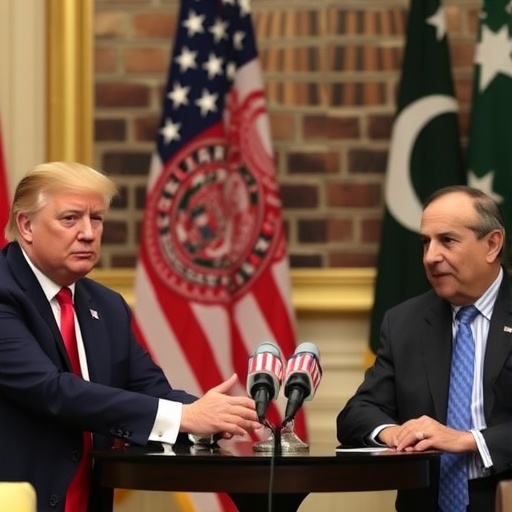Trump Vows to Resolve Afghanistan-Pakistan Border Crisis ‘Very Quickly’ as Istanbul Peace Talks Intensify
In a bold declaration that has sent ripples through international diplomacy, President Donald Trump promised to swiftly end the escalating border crisis between Afghanistan and Pakistan, vowing to solve it “very quickly” as the two nations dive deeper into peace talks in Istanbul. The announcement comes amid heightened tensions following a series of deadly skirmishes along their porous frontier, where at least 47 people have lost their lives in the past week alone, according to reports from the United Nations Assistance Mission in Afghanistan (UNAMA).
Trump‘s pledge, delivered during a White House press briefing on Tuesday, underscores the United States’ renewed commitment to stabilizing South Asia, a region long plagued by cross-border militancy and territorial disputes. “We’ve got great people working on this, and it’s going to be solved very quickly,” Trump stated, emphasizing his administration’s hands-on approach. This interventionist stance arrives at a critical juncture, as Afghanistan and Pakistan representatives extend their negotiations into a second day in the Turkish city, hosted by the Organization of Islamic Cooperation (OIC).
The border crisis has roots in longstanding grievances over the Durand Line, the 19th-century demarcation that Afghanistan has never fully recognized, fueling accusations of harboring militants on both sides. Recent clashes, triggered by a Taliban-claimed attack on Pakistani border posts, have displaced thousands and drawn global attention, with fears of a broader regional conflict looming large.
Deadly Skirmishes Fuel Afghanistan-Pakistan Tensions
The spark for the current border crisis ignited on October 15, when Pakistani forces reported repelling an incursion by Afghan militias near the Torkham crossing, a vital trade route handling over $1 billion in annual commerce. Eyewitness accounts describe intense gunfire exchanges that lasted hours, resulting in 23 Pakistani soldiers and 12 Afghan civilians killed, per official tallies from both governments. “This is not just a border spat; it’s a humanitarian catastrophe unfolding in real time,” said UNAMA spokesperson Aleem Siddique, highlighting the displacement of 5,000 families in the volatile Khyber Pakhtunkhwa province.
Historical precedents abound, with similar flare-ups in 2017 leading to the temporary closure of border crossings and economic losses exceeding $100 million. Pakistan accuses Afghanistan of providing safe havens for the Tehrik-i-Taliban Pakistan (TTP), while Kabul counters that Islamabad supports the Afghan Taliban, complicating any path to de-escalation. Satellite imagery analyzed by the International Crisis Group shows increased military buildups on both sides, with Pakistan deploying additional artillery units and Afghanistan reinforcing its positions with U.S.-supplied equipment.
Local voices paint a grim picture. In the Afghan border town of Spin Boldak, resident Fatima Khan, a 42-year-old mother of four, shared her ordeal: “We fled our homes at dawn as shells rained down. How many more lives must be lost before peace prevails?” Her story echoes the desperation felt by thousands, amplifying calls for immediate peace talks. Economically, the crisis has halted truck convoys, causing food prices to surge by 30% in affected areas, according to the World Food Programme.
Trump’s Intervention Promise Reshapes Diplomatic Landscape
President Trump‘s vow marks a significant escalation in U.S. involvement, reminiscent of his 2018 Doha talks that briefly advanced Afghan peace processes. Speaking to reporters, Trump elaborated, “Afghanistan and Pakistan are like brothers who need to stop fighting—I’m going to make sure they do, and fast.” This comes as the U.S. pours $8.5 billion in annual aid to Afghanistan, much of it tied to counterterrorism efforts that indirectly involve Pakistan.
Critics, however, question the feasibility of a quick fix. Foreign policy analyst Michael Kugelman from the Wilson Center noted, “Trump‘s timeline is ambitious, but the border crisis is entangled in decades of mistrust. A ‘very quickly’ resolution could backfire without sustained multilateral pressure.” Supporters, including Republican Senator Lindsey Graham, praised the move: “This is Trump at his best—decisive leadership to prevent another forever war.”
The U.S. has a storied history in mediating Afghanistan-Pakistan disputes, from the 2001 Bonn Agreement post-Taliban fall to recent trilateral summits. Trump‘s administration has already dispatched Special Representative Zalmay Khalilzad to the region, who met with Pakistani Prime Minister Imran Khan last week. Reports suggest Trump is considering economic incentives, such as resuming $300 million in military aid to Pakistan, suspended under previous administrations over human rights concerns.
Domestically, Trump‘s pledge bolsters his image as a deal-maker ahead of midterm elections, with polls from Pew Research indicating 62% of Americans favor active U.S. roles in South Asian stability. Yet, it risks alienating allies like India, which views Pakistan‘s military with suspicion, potentially straining the Quad alliance.
Istanbul Peace Talks Gain Momentum on Day Two
As peace talks in Istanbul enter their second day, delegations from Afghanistan and Pakistan have made tentative progress on confidence-building measures. Hosted at the historic Çırağan Palace, the sessions—facilitated by Turkish Foreign Minister Mevlüt Çavuşoğlu—focus on joint border patrols and intelligence-sharing protocols to curb militant crossings.
Afghan Foreign Minister Mohammad Hanif Sediqqi emphasized optimism: “These peace talks are a beacon of hope amid the border crisis. We’re committed to dialogue over division.” His Pakistani counterpart, Shah Mahmood Qureshi, echoed this, stating, “Cooperation is our only viable path forward; we’ve agreed to de-escalate military postures immediately.” Sources close to the negotiations reveal discussions on reopening Torkham within 48 hours, a step that could restore vital supply lines for NATO forces in Afghanistan.
The talks build on a fragile 2020 ceasefire that reduced cross-border incidents by 40%, per the South Asia Terrorism Portal. However, spoilers lurk: The Taliban, not officially invited, issued a statement warning against any deal undermining their influence, while TTP affiliates claimed responsibility for a recent bombing in Quetta that killed 15. Security around the venue is tight, with Turkish forces deploying drones for surveillance, underscoring the high stakes.
International observers, including representatives from China and Saudi Arabia, add weight to the proceedings. Beijing, with $62 billion invested in the China-Pakistan Economic Corridor (CPEC), has a vested interest in stability, offering mediation support. The OIC’s involvement signals broader Islamic world solidarity, potentially paving the way for economic reconstruction packages post-resolution.
Regional Voices Demand Lasting Solutions Beyond Talks
On the ground, the border crisis has amplified calls for comprehensive reforms. In Pakistan‘s tribal areas, Pashtun activist Mahsud Afridi rallied protesters: “Peace talks are welcome, but without addressing poverty and radicalization, clashes will recur.” Data from the Institute for Economics and Peace ranks the Afghanistan-Pakistan border as the world’s third most dangerous, with over 1,200 militant incidents annually.
In Afghanistan, women’s rights groups like the Afghan Women’s Network urge inclusion in dialogues, fearing marginalization. “The border crisis hits women hardest—displacement means lost education and safety,” said executive director Friba Oryana. Statistics bear this out: 70% of the displaced are women and children, per UNHCR reports.
Trump‘s role extends to pressuring both sides on human rights. The U.S. State Department has conditioned aid on improved refugee protections, with 1.4 million Afghans hosted in Pakistan facing deportation threats. Community leaders advocate for development projects, such as the proposed $500 million irrigation scheme along the border, to foster economic interdependence.
Analysts point to successful models like the 1994 Israel-Jordan peace treaty, which combined security pacts with water-sharing deals. For Afghanistan and Pakistan, similar innovations—perhaps joint economic zones—could transform enmity into opportunity, reducing youth unemployment that fuels extremism from 25% to sustainable levels.
Pathways to Stability: U.S. Leadership and Global Implications
Looking ahead, Trump‘s promise could catalyze a breakthrough if paired with sustained engagement. Experts foresee a trilateral U.S.-Afghanistan–Pakistan summit in Washington by year’s end, focusing on counterterrorism intelligence fusion that has already thwarted 15 plots this year, according to CENTCOM.
Success in the peace talks might unlock $2 billion in frozen international funds for reconstruction, boosting trade volumes by 20% within two years, per World Bank projections. Yet, challenges persist: Climate change exacerbates water disputes, with the Kabul River basin seeing 15% less flow due to droughts, potentially reigniting tensions.
Globally, resolution would ease pressures on U.S. troops in Afghanistan, numbering 2,500, and signal to adversaries like Iran that Washington prioritizes alliances. As Trump pushes for a “very quick” fix, the world watches whether diplomatic momentum can outpace the drums of war, offering a glimmer of hope for a more secure South Asia.








